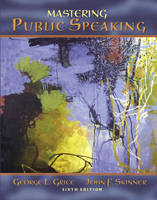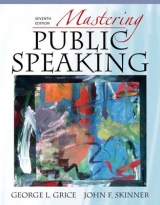
Mastering Public Speaking
Pearson (Verlag)
978-0-205-46735-8 (ISBN)
- Titel erscheint in neuer Auflage
- Artikel merken
With this top-selling book, readers learn how to think critically as they choose speech topics, conduct research, organize content, select language, manage nervousness, and deliver speeches. “Theory into Practice” and “Try This,” features help readers understand and apply concepts and strategies of public communication to enhance their speaking competence. Mastering Public Speaking adds interest and relevance to all aspects of the speech-making process.
1. An Introduction to Public Speaking.
Why Study Public Speaking?
Personal Benefits
Professional Benefits
Try This: Assessing the Importance of Communication
Public Benefits
Definitions of Communication.
Levels of Communication.
Intrapersonal Communication
Interpersonal Communication
Group Communication
Public Communication
Mass Communication
Elements of Communication.
Speaker
Message
Listener
Feedback
Channel
Environment
Noise
The Public Speaker as Critical Thinker.
Theory into Practice: Thinking about Public Speaking
Summary
Exercises
2. The Ethics of Public Speaking.
Definition of Ethics.
Principles of Ethics.
Try This: Developing a Code of Ethics
Ethical Speaking.
Speak Up about Topics You Consider Important
Choose Topics That Promote Positive Ethical Values
Speak to Benefit Your Listeners
Use Truthful Supporting Material and Valid Reasoning
Consider the Consequences of Your Words and Actions
Strive to Improve Your Public Speaking
Ethical Listening.
Seek Exposure to Well-Informed Speakers
Avoid Prejudging Speakers of Their Ideas
Evaluate the Speaker’s Logic and Credibility
Beware of the Consequences of Not Listening Carefully
Fair Use Guidelines.
Plagiarism.
Theory into Practice: Effective and Ethical Paraphrasing
Summary
Exercises
3. Speaking Confidently.
Recognize That Speaker Nervousness Is Normal.
Control Speaker Nervousness.
Learn How to Build Speaker Confidence.
Know How you React to Stress
Ethical Decisions:
Know Your Strengths and Weaknesses
Speaking with Confidence
Try This: Managing Nervous Energy
Know Speech Principles
Know that It Always Looks Worse from the Inside
Know Your Speech Believe in Our Topic
View Speech Making Positively Visualize Success
Project Confidence
Test Your Message
Practice Your Delivery
Theory into Practice: Gaining Perspective
Prepare Your First Speech.
Understand the Assignment
Develop Your Speech Content
Organize Your Speech
Word your Speech
Practice Your Speech
Deliver Your Speech
Evaluate Your Speech
Summary
Exercises
4. Responding to Speeches.
The Importance of Listening.
Listening vs. Hearing.
Listening Is Intermittent
Listening Is a Learned Skill
Listening Is Active
Listening Implies Using the Message Receives
The Process of Listening.
Speaking with Confidence
Receive
Select
Interpret
Evaluate
Resolve
Obstacles to Effective Listening.
Physical Distractions
Physiological Distractions
Psychological Distractions
Factual Distractions
Semantic Distractions
Promoting Better Listening.
Desire to Listen
Focus I the Message
Listen for Main Ideas
Understand the Speaker’s Point of View
Reinforce the Message
Provide Feedback
Listen with the Body
Withhold Judgment
Listen Critically
Critiquing Speeches.
Begin with a Positive Statement
Target a Few Areas for Improvement
Organize Your Comments
Be Specific
Be Honest but Tactful
Personalize Your Comments
Reinforce the Positive
Ethical Decisions: Title to Come
Problem-Solve the Negative
Provide the Speaker with a Plan of Action
End with a Positive Statement
Theory into Practice: Critiquing a Classmate
Acting on Criticism.
Focus on What Your Critics Say, Not How They Say It
Seek Clear and Specific Judgment
Evaluate the Feedback Your Receive
Develop a Plan of Action
Try This: Critiquing Yourself
Summary
Exercises
5. Analyzing Your Audience.
Recognize the Value of Audience Diversity.
Analyze Your Audience Before the Speech.
Analyze Audience Demographics
Speaking with Confidence
Analyze Audience Psychographics
Analyze Audience Needs
Analyze Specific Speaking Situations
Ethical Decisions: Title to Come
Theory into Practice: Using and Audience Questionnaire
Analyze Your Audience during the Speech.
Analyze Your Audience after the Speech
Try This: Incorporating Questionnaire Results
Summary
Practice Critique: Evaluating a Speaker’s Audience Analysis
Exercises
6. Selecting Your Speech Topic.
Generate Ideas.
Self-Generated Topics
Speaking with Confidence
Audience-Generated Topics
Occasion-Generated Topics
Research-Generated Topics
Theory into Practice: Selecting Your Topic.
Try This: Using a Group to Select Your Topic
Focus Your Topic.
Ethical Decisions: Should Instructors Censor?
Determine Your General Purpose.
Speeches to Inform
Speeches to Persuade
Speeches to Entertain
Formulate Your Specific Purpose.
Word Your Thesis Statement.
Develop Your Speech Title.
Summary
Practice Critique: Evaluating Titles
Exercises
7. Researching Your Topic.
Assess Your Personal Knowledge
Theory into Practice: Developing Personal Speech Resources
Develop Your Research Plan
Collect Your Information
Magazines and Journals
Try This: Comparing Online Searches
Newspapers
Government Documents
Books
Reference Works
Television and Radio
Interviews
Calling, Writing, and Emailing for Information
Record Your Information
What to Record
How to Record Information
Conclude Your Search
Summary
Practice Critique: Evaluating Research
Exercises
8. Supporting Your Speech.
Purposes of Supporting Materials.
Clarity
Vividness
Credibility
Types of Supporting Materials.
Examples
Definition
Narration
Comparison
Contrast
Statistics
Testimony
Tests of Evidence.
Is the Evidence Quoted in Context?
Is the Source of the Evidence an Expert?
Is the Source of the Evidence Unbiased?
Is the Evidence Relevant to the Point Being made?
Is the Evidence Specific?
Is the Evidence Sufficient to Prove the Point?
Ethical Decisions: Biased Sources: To Use or Not to Use
Is the Evidence Timely?
Evaluating Electronic Information.
Purpose
Expertise
Objectivity
Accuracy
Timeliness
Try This: Evaluating Internet Sources
Citing Your Sources.
Theory into Practice: Information for Oral Footnotes
Summary
Practice Critique: Evaluating Evidence
Exercises
9. Organizing the Body of Your Speech.
Formulate an Organizing Question.
Divide the Speech into Key Ideas.
Topical Division
Chronological Division
Spatial Division
Speaking with Confidence
Causal Division
Pro-Con Division
Mnemonic or Gimmick Division
Problem-Solution Division
Need-Plan Division
Develop the Key Ideas.
Signpost the Idea
State the Idea
Support the Idea
Summarize the Idea
Theory into Practice: Applying the 4 S’s
Connect the Key Ideas.
Try This: Developing One Key Idea
Ethical Decisions: Crunch Time
Summary
Practice Critique: Evaluating Organization
Exercises
10. Introducing and Concluding Your Speech.
Organize the Introduction of the Speech.
Get the Attention of Your Audience
Speaking with Confidence
State Your Topic
Ethical Decisions: Revealing vs. Concealing Your Purpose
Establish the Importance of Your Topic
Establish Your Credibility to Speak on Your Topic
Preview Your Key Ideas
Try This: Developing Introductions
Organize the Conclusion of the Speech.
Summarize Your Key Ideas
Activate Audience Response
Provide Closure
Theory into Practice: Outward Method of Speech Development
Summary
Practice Critique: Evaluating Introductions
Exercises
11. Outlining Your Speech.
Functions of Outlining.
Tests Scope of Content
Tests Logical Relation of Parts
Tests Relevance of Supporting Ideas
Checks Balance of Speech
Serves as Delivery Notes
Principles of Outlining.
Singularity
Consistency
Speaking with Confidence
Adequacy
Uniformity
Parallelism
Stages of Outlining.
The Working Outline
Theory into Practice: Visual Brainstorming
Try This: Developing a Working Outline
The Formal Outline
Sample Outline: Perfect (ly Simple) Design
The Speaking Outline
Summary
Practice Critique: Evaluating a Speech Outline
Exercises
12. Wording Your Speech.
Functions of Language.
Communicate Ideas
Send Messages about User
Strengthen Social Bonds
Serve as Instrument of Play
Check Language Use
Speaking with Confidence
Principles of Effective Language Use.
Use language Correctly
Use language Clearly
Use language Vividly
Ethical Decisions: Doublespeak or Clearspeak
Use Language Inclusively
Try This: Becoming an Inclusive Speaker
Use Oral Style
Theory into Practice: Keys to Effective Oral Style
Summary
Practice Critique: Analyzing Language Use in a Powerful Speech
Exercises
13. Delivering Your Speech.
Principles of Nonverbal Communication.
Speaking with Confidence
Methods of Delivery.
Speaking Impromptu
Speaking from Memory
Speaking from Manuscript
Speaking Extemporaneously
Qualities of Effective Delivery.
Elements of Vocal Delivery.
Rate and Pause
Volume
Pitch and Inflection
Voice Quality
Articulation and Pronunciation
Elements of Physical Delivery.
Appearance
Theory into Practice: Dressing for Address
Posture
Facial Expression
Eye Contact
Movement
Gestures
Try This: Practicing Your Delivery
Summary
Practice Critique: Pairing Gestures and Movements with Words
Exercises
14. Using Presentational Aids.
The Importance of Using Presentational Aids.
Increases Message Clarity
Reinforces Message Impact
Increases Speaker Dynamism
Enhances Speaker Confidence
Types of Presentational Aids.
Objects
Graphics
Theory into Practice: Designing Transparencies and Slides
Film and Video
Handouts
Audio and Other Aids
Strategies for Using Presentational Aids.
Before the Speech
Try This: Planning Presentational Aids for the Classroom
During the Speech
Summary
Practice Critique: Evaluating Presentational Aids
Exercises
15. Speaking to Inform.
Characteristics of a Speech to Inform.
Informative Speech Topics.
Speeches about People
Speeches about Objects
Speeches about Places
Speeches about Activities and Events
Speeches about Processes
Speeches about Concepts
Speeches about Conditions
Speeches about Issues
Try This: Targeting an Informative Topic
Theory into Practice: Organizing Informative Speeches
Guidelines for Speaking to Inform.
Stress Your Informative Purpose
Be Specific
Be Clear
Be Accurate
Limit Your Ideas and Supporting Materials
Be Relevant
Be Objective
Use Appropriate Organization
Use Appropriate Forms of Support
Use Effective Delivery
Annotated Sample Speech: The Amish: Seeking to Lose the Self.
Summary
Practice Critique: Evaluating and Comparing Two Informative Student Speeches
Exercises
16. The Strategy of Persuasion.
The Importance of Persuasion.
A Definition of Persuasion.
Types of Influence.
Change
Instill
Intensify
Theory into Practice: The Pyramid of Persuasion.
Types of Persuasive Speeches.
Speeches to Convince
Speeches to Actuate
Speeches to Inspire
Persuasive Speaking Strategies.
Establish Your Credibility
Try This: Assessing and Building Your Credibility
Focus Your Goals
Connect with Your Listeners
Organize Your Arguments
Support Your Ideas
Enhance Your Emotional Appeals
Summary
Practice Critique: Analyzing Persuasive Appeals in a Powerful Speech
Exercises
17. The Structure of Persuasion.
Making and Refuting Arguments
Steps of an Argument
Refuting an Argument
Types of Argument
Argument by Example
Argument by Analogy
Argument by Cause
Argument by Deduction
Argument by Authority
Theory into Practice: Testing Your Arguments
Fallacies of Argument.
Hasty Generalization
False Analogy
Post Hoc Ergo Propter Hoc
Slippery Slope
Red Herring
Appeal to Tradition
False Dilemma
False Authority
Bandwagon
Ad Hominem
Selecting Propositions for Persuasive Speeches.
Characteristics of Propositions
Types of Propositions
Try This: Formulating Your Persuasive Proposition
Monroe's Motivated Sequence.
Annotated Sample Speech: Diploma Mills.
Summary
Practice Critique: Identifying a Claim and Evaluating Evidence
Exercises
18. Speaking on Special Occasions.
The Speech of Introduction.
The Speech of Presentation.
The Acceptance Speech.
The Speech of Tribute.
The Speech to Entertain.
The Impromptu Speech.
The Question-Answer Period.
Try This: Anticipating and Answering Listener’s Questions
The Videotaped Speech.
Theory into Practice: Appearing on Video
Summary
Practice Critique: Evaluating a Speech of Tribute
Exercises
19. Speaking in and as a Group.
Small Group Communication and Public Speaking.
Small Groups Defined.
Types of Groups.
Try This: Analyzing Your Group
Group Discussion and Decision Making.
Principles of Group Decision Making
The Process of Group Decision Making
The Responsibilities of Group Members
The Responsibilities of Group Leaders
The Group Presentation.
Formats for the Presentation
Preparing a Groups Presentation
Theory into Practice: Developing a Presentational Style
Summary
Practice Critique: Analyzing a Group’s Interactions
Exercises
Appendix: Sample Speeches.
Renaissance Fairs, Melissa Janoske
Critique of Renaissance Fairs, Donika K. Patel
Steganography, Tiffanie K. Petrin
A Sign of the Times, Jared J. Johnston
How Old Is He Anyway? Aging the Whitetail Buck, Darla Goodrich
Persuasive Speech, Gene Fox
Speech of Tribute, Edwin C. Anderson, Jr.
I Have a Dream, Martin Luther King Jr.
| Erscheint lt. Verlag | 11.5.2006 |
|---|---|
| Sprache | englisch |
| Maße | 217 x 278 mm |
| Gewicht | 968 g |
| Themenwelt | Sachbuch/Ratgeber ► Beruf / Finanzen / Recht / Wirtschaft ► Briefe / Präsentation / Rhetorik |
| ISBN-10 | 0-205-46735-0 / 0205467350 |
| ISBN-13 | 978-0-205-46735-8 / 9780205467358 |
| Zustand | Neuware |
| Informationen gemäß Produktsicherheitsverordnung (GPSR) | |
| Haben Sie eine Frage zum Produkt? |
aus dem Bereich



